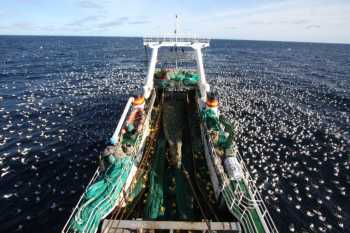Johanna Pierre and colleagues have had a paper accepted in the journal Emu Austral Ornithology that looks at different treatments of trawl offal discharge on seabird attraction.
The paper's in-press abstract follows:
"Seabird bycatch on trawl fishing gear has been reported worldwide, and is exacerbated by the discharge of fish waste. We compared the attraction of seabirds to three forms of fishery waste (unprocessed discharge (offal, fish discards), hashed discharge (smaller chunks passed through a hasher pump), and cutter pump discharge (waste passed through the hasher and a cutter pump to further reduce particle size), to identify the discharge regime that most effectively reduced the risk of seabird bycatch. Seabird responses were the abundances of large albatrosses (Diomedea spp.), small albatrosses and giant petrels (all other albatrosses, Macronectes giganteus, M. halli), Cape petrels (Daption capense), and all other procellarid [sic] species within specified areas astern the vessel. Seabirds on the water were less numerous during cutter pump and hashed discharge, relative to unprocessed discharge (except small albatross, cutter treatment). Also, in some cases, the total number of birds decreased, relative to unprocessed discharge treatments (but not small and large albatrosses - cutter treatment). Particle size may be less important for reducing abundances than temporal discharge patterns, which affected how birds tracked the discharge stream. Manipulating discharge characteristics can reduce seabird attraction to fishing vessels, however bycatch risk remained lowest when no discharging occurred."

Waiting for waste: albatrosses gather behind a trawler
Photograph by Graham Parker
Reference:
Pierre, J., Abraham, E., Cleal, J. & Middleton, D. 2012. Reducing effects of trawl fishing on seabirds by limiting foraging opportunities provided by fishery waste. Emu Austral Ornithology. MU12002 Accepted 16 May 2012.
John Cooper, ACAP Information Officer, 26 July 2012

 English
English  Français
Français  Español
Español